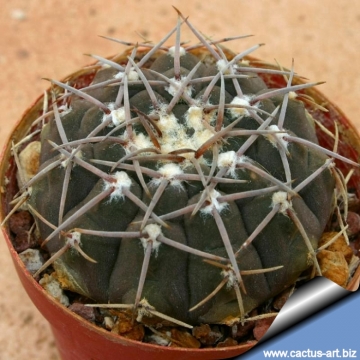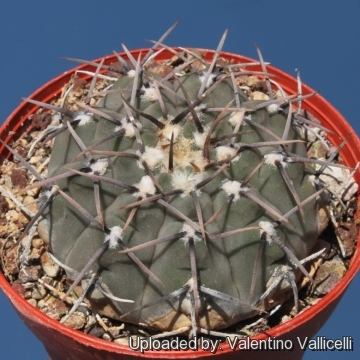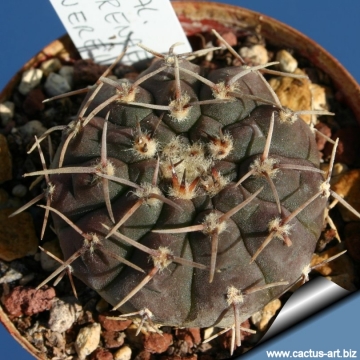Accepted Scientific Name: Gymnocalycium ochoterenae Backeb.
Kaktus-ABC [Backeb. & Knuth] 293, 417, 1936 Backeb., F.M.Knuth

Gymnocalycium ochoterenae var. cinereum Photo by: Valentino Vallicelli
Origin and Habitat: Near San Francisco Del Monte De Oro, San Luis, Argentina
Altitude: Around 700-800 metres above sea level.
Synonyms:
See all synonyms of Gymnocalycium ochoterenae
Description: Gymnocalycium ochoterenaeSN|13754]]SN|13754]] var. cinereum|SN|13755]] is a small slow-growing cactus barely rising above ground level that differs from the other Gymnocalycium ochoterenaeSN|13754]]SN|13754]] for the pale to dark greyish-green stem (often brown coloured in ochoterenae) and for the cream-white flowers.
Stem: Flattened hemispherical to spherical, grey-green to olive green, 3-4,5 cm tall and up to 8 cm in diameter.
Ribs: 9 to -16 wide and flat, or slightly tuberculate.
Areoles: Round to oval, initially felted but soon naked .
Roots: Branched taproot.
Central spine: Often lacking.
Radial spines: usually 3 needle-like, stiff, straight, bent back on the body, pointing downward, brownish becoming grey, 1-1,5 cm (or more) long.
Flower: Funnel-shaped, creamy-white with pale pink throat, 3,5-5,5 cm (rarely more) long and 3,5-5,5 cm in diameter.
Fruit: Barrel shaped green to dull red, 1,5-2(-3) cm long and1,5-2 cm in diameter.
Subspecies, varieties, forms and cultivars of plants belonging to the Gymnocalycium ochoteranae group
 Gymnocalycium intermedium Piltz non Hildm.: has squat dull grey-green or blue green epidermis, and usually 3 spines. Distribution: East of Salsacate, Cordoba, Argentina.
Gymnocalycium intermedium Piltz non Hildm.: has squat dull grey-green or blue green epidermis, and usually 3 spines. Distribution: East of Salsacate, Cordoba, Argentina. Gymnocalycium ochoterenae Backeb.: (ssp. ochoterenae) It has 3-5 recurving radial spines. Distribution: Widespread in Cordoba, and San Luis, Argentina.
Gymnocalycium ochoterenae Backeb.: (ssp. ochoterenae) It has 3-5 recurving radial spines. Distribution: Widespread in Cordoba, and San Luis, Argentina.  Gymnocalycium ochoterenae var. cinereum Backeb.: (ssp. ochoterenae) has pale to dark greyish-green stem (often brown coloured in ochoterenae) and cream-white flowers. Distribution: San Francisco Del Monte De Oro, San Luis, Argentina
Gymnocalycium ochoterenae var. cinereum Backeb.: (ssp. ochoterenae) has pale to dark greyish-green stem (often brown coloured in ochoterenae) and cream-white flowers. Distribution: San Francisco Del Monte De Oro, San Luis, Argentina- Gymnocalycium ochoterenae subs. herbsthoferianum H.Till & Neuhuber: It has 6-7 pectinate radial spines; it occurs near Lujan, San Luis.
 Gymnocalycium ochoterenae var. scoparium H.Till & Neuhuber: (ssp. ochoterenae) has longer light coloured brushy spines, longer spherical stems, and most prominent tubercles. Distribution: west of Quines (base of Lujan mountains), San Luis, Argentina.
Gymnocalycium ochoterenae var. scoparium H.Till & Neuhuber: (ssp. ochoterenae) has longer light coloured brushy spines, longer spherical stems, and most prominent tubercles. Distribution: west of Quines (base of Lujan mountains), San Luis, Argentina. Gymnocalycium ochoterenae subs. vatteri (Buining) Papsch: It has only 1-3 recurved spines. Distribution: it occurs in Cordoba.
Gymnocalycium ochoterenae subs. vatteri (Buining) Papsch: It has only 1-3 recurved spines. Distribution: it occurs in Cordoba.
Bibliography: Major references and further lectures
1) Edward Anderson “The Cactus family” Timber Press, Incorporated, 2001
2) James Cullen, Sabina G. Knees, H. Suzanne Cubey "The European Garden Flora Flowering Plants: A Manual for the Identification of Plants Cultivated in Europe, Both Out-of-Doors and Under Glass" Cambridge University Press, 11/Aug/2011
3) David R Hunt; Nigel P Taylor; Graham Charles; International Cactaceae Systematics Group. "The New Cactus Lexicon" dh books, 2006
4) N. L. Britton, J. N. Rose “The Cactaceae. Descriptions and Illustrations of Plants of the Cactus Family.” Volume 4, The Carnegie Institution of Washington, Washington 1923
5) Curt Backeberg “Die Cactaceae: Handbuch der Kakteenkunde” Gustav Fischer Verlag, Stuttgart New York 1982–1985
 Gymnocalycium ochoterenae var. cinereum Photo by: Cactus Art
Gymnocalycium ochoterenae var. cinereum Photo by: Cactus Art Gymnocalycium ochoterenae var. cinereum Photo by: Valentino Vallicelli
Gymnocalycium ochoterenae var. cinereum Photo by: Valentino Vallicelli Gymnocalycium ochoterenae var. cinereum Photo by: Cactus Art
Gymnocalycium ochoterenae var. cinereum Photo by: Cactus ArtSend a photo of this plant.The gallery now contains thousands of pictures, however it is possible to do even more. We are, of course, seeking photos of species not yet shown in the gallery but not only that, we are also looking for better pictures than those already present.
Read More... Cultivation and Propagation: Gymnocalycium ochoterenaeSN|13754]]SN|13754]] var. cinereum is a summer grower species that is easy to cultivate.
Growth rate: It is a relatively slow growing but easily flowering species.
Soils: It likes very porous standard cactus mix soil. Prefer a low pH compost, avoid substrata rich in limestone; otherwise growth will stop altogether.
Repotting: This plant needs plenty of space for its roots, repotting should be done every other year or when the it has outgrown its pot. Use pot with good drainage.
Watering: Needs moderate to copious waterings in summer, but do not overwater (Rot prone), keep dry in winter at a minimum temperature of 0°C.
Fertilization: Feed with a high potassium fertilizer in summer.
Hardiness: Reputedly resistant to frost if kept on the dry side prior to, and during, cold weather (hardy to -5 C ° C, or less for short periods).
Exposition: The plant tolerates extremely bright situations but enjoys filtered sunlight or afternoon shade, inside it needs bright light, and some direct sun. Tends to bronze in strong light, which encourages flowering and heavy spine production, but is likely to suffer from sun scorch or stunted growth if over exposed to direct sunlight during the hottest part of the day in summer.
Uses: It is an excellent plant for container growing. It always looks good and stays small. It look fine in a cold greenhouse and frame or outdoor in a rockery.
Pests & diseases: It may be attractive to a variety of insects, but plants in good condition should be nearly pest-free, particularly if they are grown in a mineral potting-mix, with good exposure and ventilation. Nonetheless, there are several pests to watch for:
- Red spiders: Red spiders may be effectively rubbed up by watering the plants from above.
- Mealy bugs: Mealy bugs occasionally develop aerial into the new growth among the wool with disfiguring results, but the worst types develop underground on the roots and are invisible except by their effects.
- Scales: Scales are rarely a problem.
- Rot: This species is particularly easy and accommodating, seldom suffer of cryptogamic diseases. Rot it is only a minor problem with gymnocalyciums if the plants are watered and “aired” correctly. If they are not, fungicides won't help all that much.
Propagation: Division, direct sow after last frost. Seeds germinate in 7-14 days at 21-27° C in spring, remove gradually the glass cover as soon the plants will be well rooted (ca 1-2 weeks) and keep ventilated, no full sun for young plants! To make a cutting twist off a branch and permit it to dry out a couple of weeks, lay it on the soil and insert the stem end partially into the soil. Try to keep the cutting somewhat upright so that the roots are able to grow downward.














